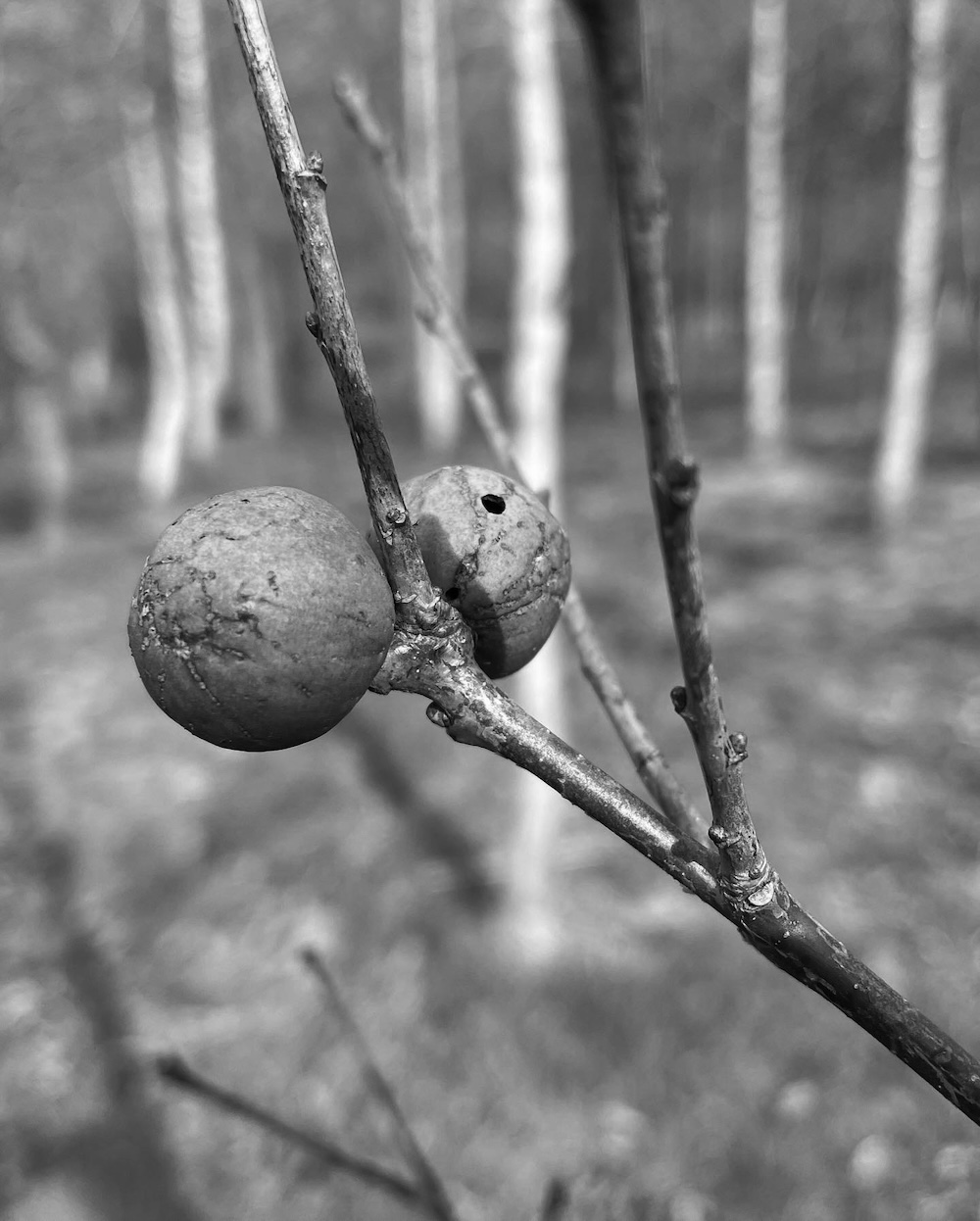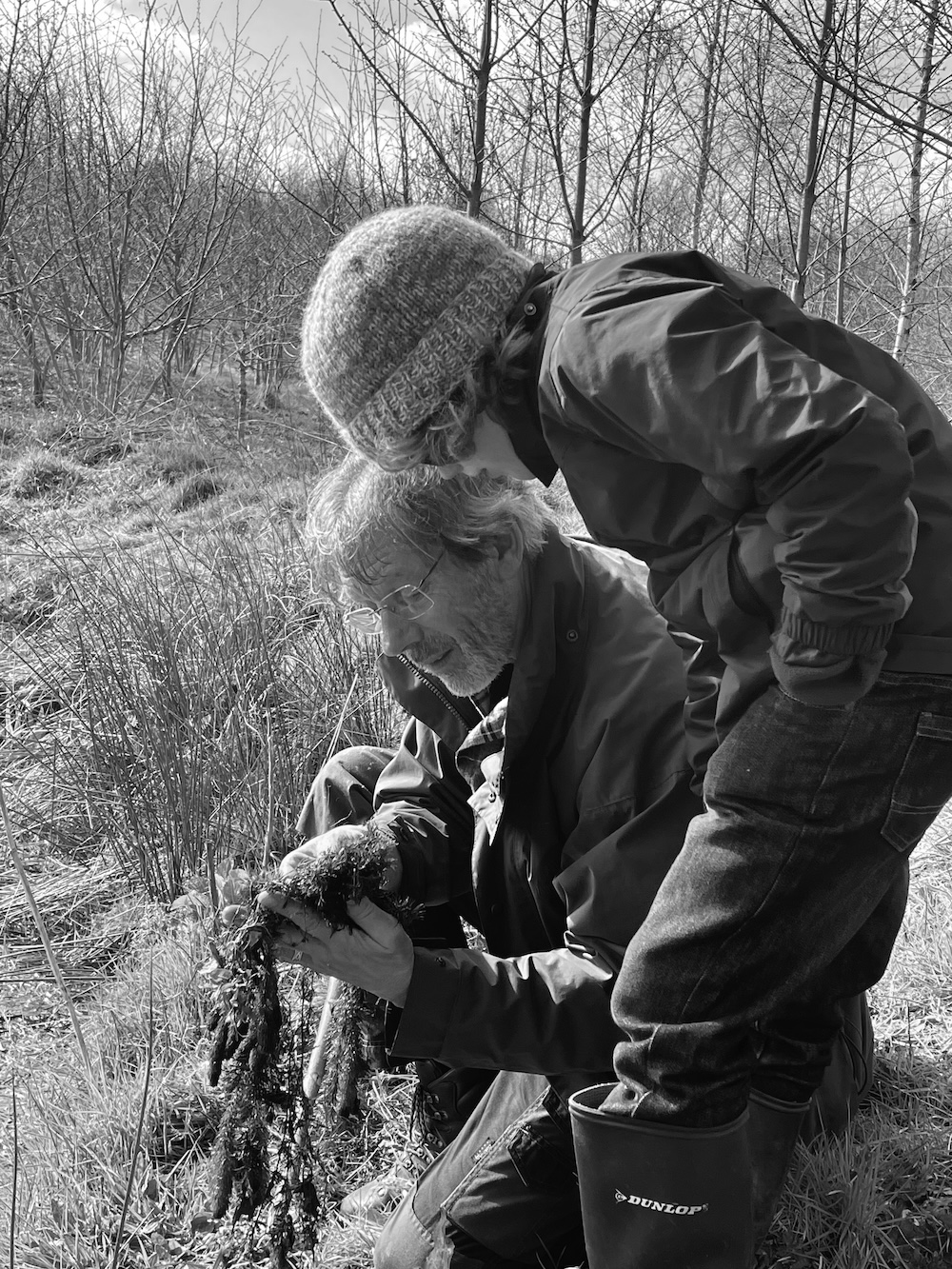An extract about legacies, oak galls and planting trees from Wyl Menmuir’s ‘The Heart of the Woods’, newly published by Aurum. With photos courtesy of Wyl Menmuir.

It was early spring and branches that were bare just a week ago beginning to show green. I was wandering between tall, spindly trunks, looking at the tips of the branches, at their becomings, on the first day of the year in which I could feel the sun’s warmth on my face. Some of these young trees were holding tightly to their leaves in bunched buds, dark and smooth, while others had put out tentative tips and blades in the hope, perhaps, that the last of the hard frosts had passed. Even compared to the previous day, the trees were looking greener, as though they were impatient to become their summer selves.
The trees I was looking at were the ones my father planted nine years before, on the outskirts of a small village in North East Wales, close to the Berwyn Mountains. He wanted to create something that would outlast him, a canopy beneath which his grandchildren and their children could find shade, a source of wood for the fire, a sustainable building material and, perhaps above all of that, a small contribution to addressing the loss of biodiversity in the landscape in which he lives.
Nearby, I could hear him talking to my ten-year-old son, Tom about the galls, the spherical woody growths which sat, improbably bulbous, on the thin, bare branches of the oaks. Tom, leaning on my father’s hazel walking stick with both hands, had his face up close to one of the galls as my father explained that the oak apples were the birthplace of tiny wasps, pointing out the minuscule hole in each of the galls where a wasp had emerged. When Tom was satisfied that they were now vacant properties, he and Dad picked some and stuffed them into their pockets.
They were roughly the same age, Tom and the trees. Just five months separated Tom’s birth and their planting, though adjust that for the fact that Tom arrived almost nine weeks earlier than expected, and you could barely fit a cigarette paper between their ages. I have marked Tom’s growth alongside theirs, from carrying him around them in a sling when the saplings were barely up to my waist, still wrapped in their plastic deer guards, to watching them tower over him in full leaf as he walked the patch of land with the confidence of someone who has known this place his whole life.

Later, when we returned home to Cornwall, I would find the dun brown oak galls rolling around in the washing machine drum after some had managed to remain concealed in Tom’s trouser pockets on their journey through the laundry pile. The majority, though, made their way into his bedside drawer, where precious things are stored, among the Pokémon cards, LEGO mini figures and key rings yet to find keys.
For a while, he would carry a couple of the galls around with him like little talismans. Was the draw to do that similar to mine, the one that leads me when walking beneath autumn trees, to pocket particularly fine acorns which I then forget about until some months later when I root around for change or a tissue, and experience the satisfaction of feeling that smooth shell, the rough cup in which it sits? I will find somewhere to plant it, in the hope that it might take root on the edge of a field or a path, or somewhere out of the way where it might stand a chance of growing. As I watched my father and son, I realized I still had a couple on me from the last time I had visited the year before, when the road to Oswestry, the nearest town in Shropshire, was blanketed in acorns. And there it was, that familiar thrill, the realization that within the tiny shell in my pocket there was the potential for a massive oak, waiting for its chance – an acorn is like a benevolent hand grenade.
Just as Tom knew nothing about my habit of collecting and redis tributing acorns, I did not realize, until I started to talk about it, how many other people do something similar yet keep it to themselves. There is an echo in that of the story of the most famous of acorn distributors, Admiral Cuthbert Collingwood, Nelson’s second in command at the Battle of Trafalgar. When Collingwood was home from sea, on his estate in College Valley in Northumberland, he would set out walking with a pocket full of acorns and plant them wherever he thought would be a good place for oaks to grow. He had in mind the protection of Britain and the future of its navy, and in particular the nation’s ability to build more ships which were constructed largely of oak. It took 2–3,000 oaks to build a ship like the 104-gun HMS Victory. While Collingwood knew he would never live to see his oaks grow to a size where they could be fashioned into the planks of a hull,3 and could not have foreseen that by that time, the navy would be reliant on metal and steam rather than wooden sailing ships, his oaks were a thought experiment, a hope for the future.
Legacies are funny things, aren’t they? Unpredictable. Uncertain. Our intentions yielding mixed results. Like my father, Collingwood wanted to be a good ancestor, channelling the phrase that appears in one form or another in cultures across the world: ‘blessed is he who plants trees under whose shade he will never sit’.
*
‘The Heart of the Woods’ by Wyl Menmuir (£16.99, Aurum) is out now.